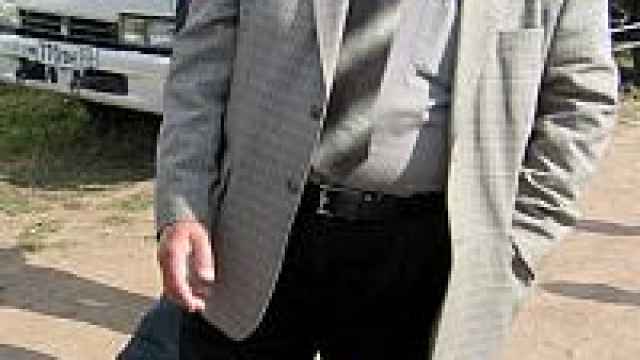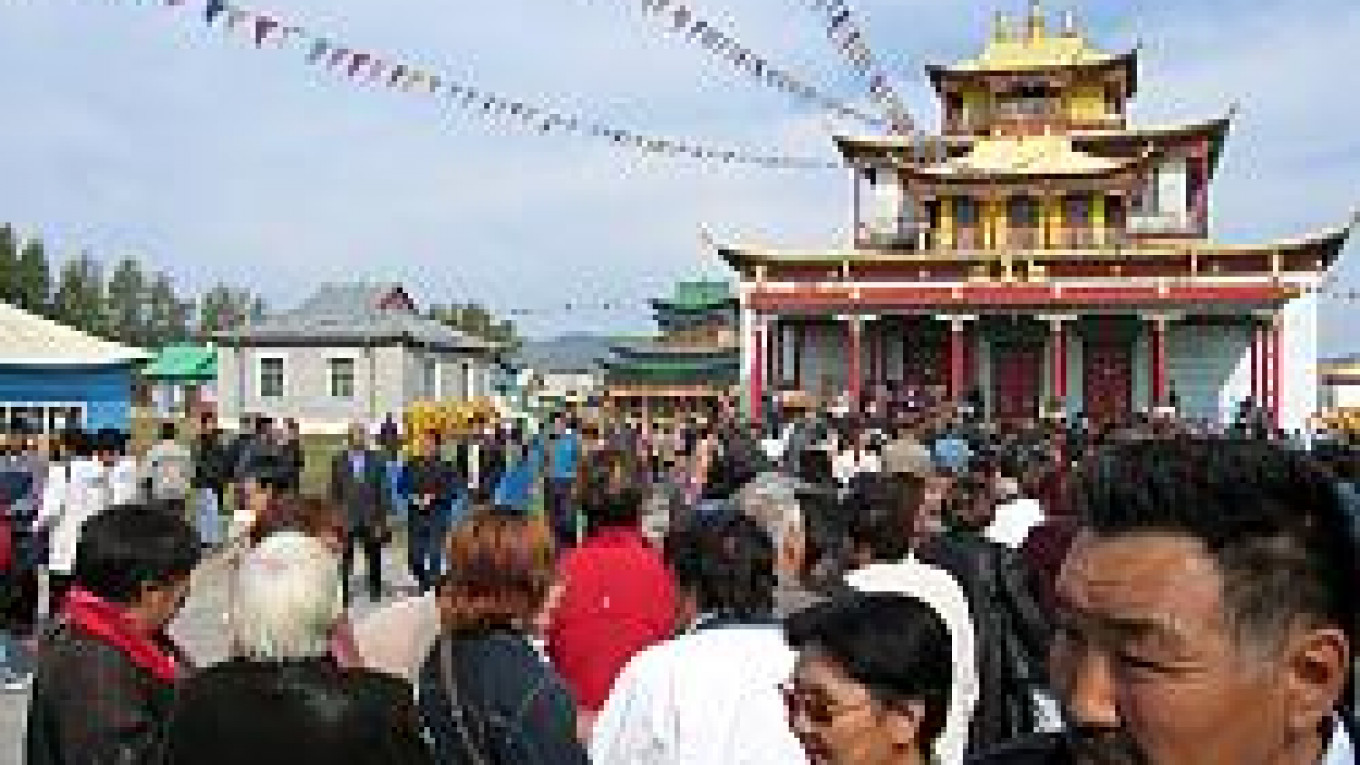Click here to see photo essay
Thirty kilometers west of Ulan-Ude, the road reaches the gates of Ivolginsky Datsan, which was one of only two approved centers of Buddhist worship in the Soviet Union when construction began there in 1946. Josef Stalin had ordered the destruction of 46 other Buddhist centers and sent thousands of monks to their death during the Great Terror of the 1930s. Today, Ivolginsky Datsan is a complex of temples and residences that includes an accredited university.
It also houses what many call a miracle.
The body of the 12th Pandito Khambo Lama, Dasha-Dorzho Itigilov, who served as the spiritual leader of Russian Buddhism from 1911 to 1917, was publicly unveiled for the first time in September 2002, 75 years after his death in 1927. Three years later, his body remains in a state of preservation that has baffled scientists -- and drawn believers by the thousands.
This Sept. 7, when the third anniversary of the holiday was celebrated according to the Buddhist calendar, minibuses from the capital arrived steadily all morning, bearing the first of the pilgrims. They had come in part for the day's festivities: song and dance performances in the afternoon, followed by competitions in archery, wrestling and horseracing, with five new Zhigulis for the winners.
They had also come to see the miracle with their own eyes.
"My wife and I drove here from Irkutsk to see it last week, but the monks told us we had to come back this week," said Vyacheslav Simonov, 53. "It's a long drive, but we had to come back."
By decision of the current Khambo Lama, Damba Ayusheyev, Itigilov's body is exhibited only seven days a year, during Buddhist holidays.
Itigilov Institute director Yanzhima Vasilyeva, a small woman brimming over with enthusiasm, told the lama's story while the line of pilgrims grew.
Itigilov was born in 1852 and began his religious education at the age of 16. In 1911, he was appointed Khambo Lama, a post he used to institute a Buddhist revival among Buryats. He was a guest of Tsar Nicholas II during the 300th anniversary celebrations of the Romanov dynasty in 1913, and he remained an influential figure after stepping down from his post in 1917.
Ten years later, Vasilyeva said, Itigilov warned his students about the coming terror and advised them to flee to Tibet.
"He then sat down to meditate and passed into another state, leaving his body behind," she said. "He was 75 years old, and he promised to return to his followers after another 75 years."
The Khambo Lama's body was buried sitting upright in the lotus position. It was exhumed twice after fierce storms his followers took as signs: once in 1955, and again in 1973. Both times they found the body perfectly preserved, said Vasilyeva, who is also Itigilov's great-niece.
"His limbs were still flexible and his skin was elastic," Vasilyeva said. "The most amazing thing is that he was still sitting upright. Scientists say that after two weeks a dead body cannot stay upright on its own."
As Vasilyeva spoke near the entrance to the temple where Itigilov's body was being shown, a circle of pilgrims gathered around her, nodding and whispering. "Think how much you have to love people to leave them your body," Vasilyeva said.
After the first two exhumations, Itigilov was reburied. On Sept. 11, 2002, he was exhumed again and brought to Ivolginsky Datsan, where Ayusheyev, the current Khambo Lama, decided to exhibit Itiligov's body to help spread the faith.
"There is a great moral crisis in Russia today," Vasilyeva said. "Itigilov's return presents a great opportunity to help people believe."
Professor Viktor Zvyagin of the Federal Center of Forensic Medicine examined Itigilov's body in Ivolginsk last November, and conducted analyses of hair, skin and nail specimens after his return to Moscow. He concluded that Itigilov's body was in the condition of someone who had died 36 hours ago.
"In my years of practice I have encountered quite a few instances of preserved bodies, but those were either the result of mummification" or extreme environmental conditions, Zvyagin said by telephone on Wednesday. "But this is something different, and for me, incomprehensible. It's a phenomenon that calls for the most detailed research."
Pilgrims began their visit by walking a clockwise path around the datsan, or monastery, placing coins in collection boxes and spinning mounted prayer wheels of all shapes and sizes.
They then lined up and waited for more than an hour to enter the main temple. Wheelchairs and crutches were common sights, as many believe the touch of Itigilov's scarf has healing powers.
Inside, the temple is a riot of colors, with painted dragons spiraling up columns, and hundreds of portraits and statues of the Buddha in various incarnations. Itigilov sits in a glass case in the front of the temple, dressed in bright gold and orange robes. His body is slumped slightly forward, and his eyes and nose are sunken in.
 Stephen Boykewich / MT Anatoly Zhalsarayev | |
Back outside, the afternoon was blindingly bright. Archers with sneakers and track pants showing under their velvety national costumes strung their bows. Pairs of wrestlers circled each other, getting loose for their chance at one of the boxy Zhiguli cars donated by Rosgosstrakh, the formerly state-owned insurance company.
Anatoly Zhalsarayev, a member of the republic's committee on community affairs and religious organizations, stood by the datsan's gates and greeted many pilgrims by name. He said that the importance of the Itigilov phenomenon transcended the Buddhist faith.
"At critical moments in Russian history, certain miraculous events have reminded us that everything in life is relative, that we all need to seek a higher goal," he said.
"We shouldn't believe in Bush or Putin, we should believe in God. There are different religions, but there's just one God."
Simonov seemed proof that the phenomenon's appeal was not limited by creed. The man who had made the drive from Irkutsk twice in seven days sat perched on his heels amid food and souvenir vendors while his wife ate a plate of steaming pozy -- the spiced beef dumplings that are a staple of Buryat cuisine.
"I'm not a Buddhist, I'm a Jew. But I still thought it was important to see things with my own eyes," he said. "I don't know if it's a miracle, but I know he was a holy man."
A Message from The Moscow Times:
Dear readers,
We are facing unprecedented challenges. Russia's Prosecutor General's Office has designated The Moscow Times as an "undesirable" organization, criminalizing our work and putting our staff at risk of prosecution. This follows our earlier unjust labeling as a "foreign agent."
These actions are direct attempts to silence independent journalism in Russia. The authorities claim our work "discredits the decisions of the Russian leadership." We see things differently: we strive to provide accurate, unbiased reporting on Russia.
We, the journalists of The Moscow Times, refuse to be silenced. But to continue our work, we need your help.
Your support, no matter how small, makes a world of difference. If you can, please support us monthly starting from just $2. It's quick to set up, and every contribution makes a significant impact.
By supporting The Moscow Times, you're defending open, independent journalism in the face of repression. Thank you for standing with us.
Remind me later.


